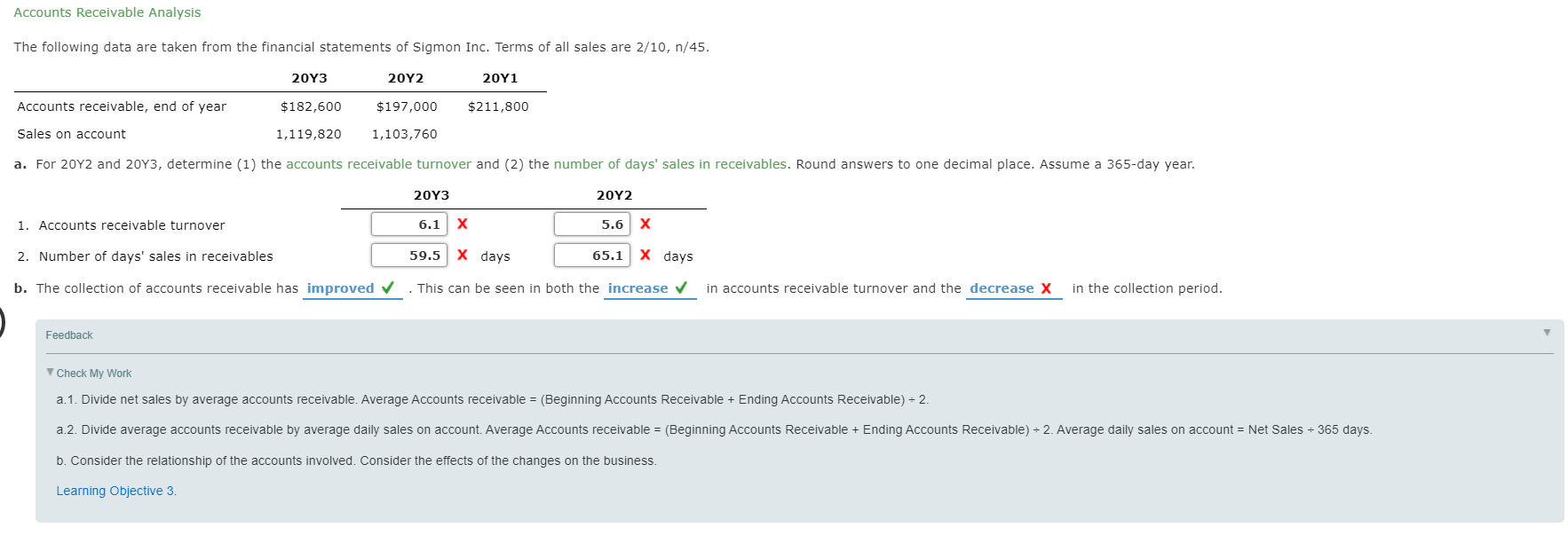The following data are taken from the financial statements of Sigmon Inc. Terms of all sales are 2/10, n/45. 20Υ3 20Υ2 20Υ1 Accounts receivable, end of year $182,600 $197,000 $211,800 Sales on account 1,119,820 1,103,760 a. For 20Y2 and 20Y3, determine (1) the accounts receivable turnover and (2) the number of days' sales in receivables. Round answers to one decimal place. Assume a 365-day year. 20Y3 20Y2 1. Accounts receivable turnover 6.1 5.6 x X days 65.1 X days 2. Number of days' sales in receivables 59.5 b. The collection of accounts receivable has improved . This can be seen in both the increase v in accounts receivable turnover and the decrease X in the collection period. Feedback V Check My Work a.1. Divide net sales by average accounts receivable. Average Accounts receivable = (Beginning Accounts Receivable + Ending Accounts Receivable) = 2. a.2. Divide average accounts receivable by average daily sales on account. Average Accounts receivable = (Beginning Accounts Receivable + Ending Accounts Receivable) - 2. Average daily sales on account = Net Sales - 365 days. b. Consider the relationship of the accounts involved. Consider the effects of the changes on the business. Learning Objective 3.
The following data are taken from the financial statements of Sigmon Inc. Terms of all sales are 2/10, n/45. 20Υ3 20Υ2 20Υ1 Accounts receivable, end of year $182,600 $197,000 $211,800 Sales on account 1,119,820 1,103,760 a. For 20Y2 and 20Y3, determine (1) the accounts receivable turnover and (2) the number of days' sales in receivables. Round answers to one decimal place. Assume a 365-day year. 20Y3 20Y2 1. Accounts receivable turnover 6.1 5.6 x X days 65.1 X days 2. Number of days' sales in receivables 59.5 b. The collection of accounts receivable has improved . This can be seen in both the increase v in accounts receivable turnover and the decrease X in the collection period. Feedback V Check My Work a.1. Divide net sales by average accounts receivable. Average Accounts receivable = (Beginning Accounts Receivable + Ending Accounts Receivable) = 2. a.2. Divide average accounts receivable by average daily sales on account. Average Accounts receivable = (Beginning Accounts Receivable + Ending Accounts Receivable) - 2. Average daily sales on account = Net Sales - 365 days. b. Consider the relationship of the accounts involved. Consider the effects of the changes on the business. Learning Objective 3.
College Accounting, Chapters 1-27
23rd Edition
ISBN:9781337794756
Author:HEINTZ, James A.
Publisher:HEINTZ, James A.
Chapter15: Financial Statements And Year-end Accounting For A Merchandising Business
Section: Chapter Questions
Problem 4SEA: FINANCIAL RATIOS Based on the financial statements for Jackson Enterprises (income statement,...
Related questions
Question
Help me solve question 1 and 2

Transcribed Image Text:The following data are taken from the financial statements of Sigmon Inc. Terms of all sales are 2/10, n/45.
20Υ3
20Υ2
20Υ1
Accounts receivable, end of year
$182,600
$197,000
$211,800
Sales on account
1,119,820
1,103,760
a. For 20Y2 and 20Y3, determine (1) the accounts receivable turnover and (2) the number of days' sales in receivables. Round answers to one decimal place. Assume a 365-day year.
20Y3
20Y2
1. Accounts receivable turnover
6.1
5.6 x
X days
65.1 X days
2. Number of days' sales in receivables
59.5
b. The collection of accounts receivable has improved . This can be seen in both the increase v
in accounts receivable turnover and the decrease X
in the collection period.
Feedback
V Check My Work
a.1. Divide net sales by average accounts receivable. Average Accounts receivable = (Beginning Accounts Receivable + Ending Accounts Receivable) = 2.
a.2. Divide average accounts receivable by average daily sales on account. Average Accounts receivable = (Beginning Accounts Receivable + Ending Accounts Receivable) - 2. Average daily sales on account = Net Sales - 365 days.
b. Consider the relationship of the accounts involved. Consider the effects of the changes on the business.
Learning Objective 3.
Expert Solution
This question has been solved!
Explore an expertly crafted, step-by-step solution for a thorough understanding of key concepts.
This is a popular solution!
Trending now
This is a popular solution!
Step by step
Solved in 3 steps with 1 images

Knowledge Booster
Learn more about
Need a deep-dive on the concept behind this application? Look no further. Learn more about this topic, accounting and related others by exploring similar questions and additional content below.Recommended textbooks for you

College Accounting, Chapters 1-27
Accounting
ISBN:
9781337794756
Author:
HEINTZ, James A.
Publisher:
Cengage Learning,

College Accounting, Chapters 1-27 (New in Account…
Accounting
ISBN:
9781305666160
Author:
James A. Heintz, Robert W. Parry
Publisher:
Cengage Learning

Managerial Accounting: The Cornerstone of Busines…
Accounting
ISBN:
9781337115773
Author:
Maryanne M. Mowen, Don R. Hansen, Dan L. Heitger
Publisher:
Cengage Learning

College Accounting, Chapters 1-27
Accounting
ISBN:
9781337794756
Author:
HEINTZ, James A.
Publisher:
Cengage Learning,

College Accounting, Chapters 1-27 (New in Account…
Accounting
ISBN:
9781305666160
Author:
James A. Heintz, Robert W. Parry
Publisher:
Cengage Learning

Managerial Accounting: The Cornerstone of Busines…
Accounting
ISBN:
9781337115773
Author:
Maryanne M. Mowen, Don R. Hansen, Dan L. Heitger
Publisher:
Cengage Learning

Managerial Accounting
Accounting
ISBN:
9781337912020
Author:
Carl Warren, Ph.d. Cma William B. Tayler
Publisher:
South-Western College Pub

Principles of Accounting Volume 1
Accounting
ISBN:
9781947172685
Author:
OpenStax
Publisher:
OpenStax College

Survey of Accounting (Accounting I)
Accounting
ISBN:
9781305961883
Author:
Carl Warren
Publisher:
Cengage Learning